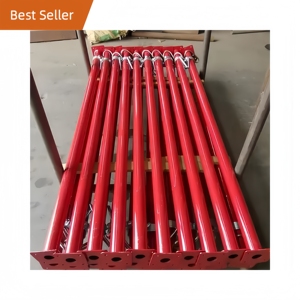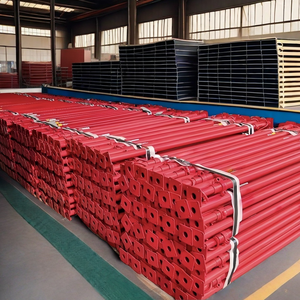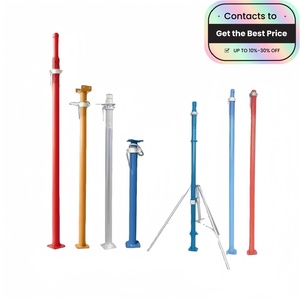
All categories
Featured selections
Trade Assurance
Buyer Central
Help Center
Get the app
Become a supplier

(2218 products available)






































A concrete bucket crane is a crane that is used for transporting concrete. There are various types of concrete crane buckets to choose from.
Standard crane buckets are the most common type of concrete crane bucket. They are usually suspended from a cable or a chain. During the concrete pouring process, the operator will use the cable or chain to release the concrete where it is needed. Crane buckets are usually attached to a crane or a boom truck. Standard crane buckets are designed in a way that allows them to easily move the concrete to wherever it is needed. This is why they are commonly used in construction projects. Standard crane buckets come in different sizes, and the most common sizes are between 0.5 to 5 cubic yards.
Clamshell crane buckets are a type of concrete bucket that are also suspended from a cable or a chain. However, they have a different design from the standard crane buckets. Clamshell crane buckets have two hinged pieces that open like a clamshell. This feature makes it possible for the operator to control the flow and placement of the concrete with more precision. Clamshell crane buckets are mostly used in projects where there is a need for accuracy, such as underwater construction or repairs. They are also used in projects that require confined spaces. Clamshell crane buckets are usually available in smaller sizes, like 0.5 to 2 cubic yards.
Concrete pump buckets are a type of concrete bucket that is attached to a concrete pump. They are also known as boom pumps. Concrete pump buckets use a hydraulic arm to place the concrete with precision. This feature makes it possible for them to access hard-to-reach areas. Concrete pump buckets are perfect for residential projects or indoor construction. They are suitable for projects that require precise placement of concrete. They are also suitable for projects that have limited access. Concrete pump buckets come in different sizes, from 20 to 70 meters in length.
Concrete skip specifications may vary depending on the crane type. The following are some common concrete bucket specifications and their maintenance requirements:
The capacity of the concrete bucket is measured in liters or cubic meters. The capacity of a concrete bucket will depend on the size of the construction project and the type of crane being used. It can be anywhere from 150L to 2000L. The maintenance requirement is to ensure the maximum capacity is not exceeded to avoid damage to the bucket and maintain safety.
Concrete buckets are usually made of metal, such as steel or aluminum alloy, or composite materials like plastic or fiberglass. Metal concrete buckets are more durable and suitable for large-scale construction projects. The maintenance requirement is to check the material for signs of wear, damage, or corrosion. If any is found, it should be repaired or replaced promptly to ensure the structural integrity and longevity of the concrete bucket.
Some concrete buckets are equipped with discharge mechanisms, such as gates or chutes, to control the flow of concrete. The maintenance requirement is to keep the discharge mechanism clean and free of hardened concrete to ensure it functions properly. Operators should regularly lubricate and inspect the moving parts of the mechanism to avoid mis-operation and ensure it works smoothly and accurately.
Some concrete buckets are equipped with safety features, such as latches, anti-drop systems, and overload indicators, to enhance safety. The maintenance requirement is to inspect and test the safety features regularly. Make sure they are functioning correctly and effectively. Ensure safety latches are properly engaged before lifting or moving the concrete bucket, and always follow the safety guidelines and operational procedures.
A concrete bucket for a crane or a concrete crane bucket is commonly used in the following construction project scenarios:
Concrete crane buckets are ideal for high-rise buildings and other large-scale construction projects. They can transport and pour concrete at great heights with stability and precision.
Concrete crane buckets are widely used for bridges, overpasses, dams, and other infrastructure projects. Their reach and versatility make them suitable for pouring concrete in large and complex structural forms.
Concrete crane buckets are frequently used in the construction of industrial facilities such as factories, warehouses, and power plants. They can efficiently pour concrete to form the large, durable structures needed in industrial settings.
Concrete crane buckets are commonly used in residential construction, including single-family homes, apartment buildings, and condominiums. Their precision and control are valuable for pouring concrete in residential structures with diverse architectural features.
Concrete crane buckets are indispensable for highway and road construction projects. They can efficiently pour concrete for various components, such as roadways, bridges, and tunnels. Concrete crane buckets help ensure the durability and stability of road infrastructure.
Concrete crane buckets can also be used in specialized construction applications, such as underwater construction, tight urban sites, and remote locations. Their flexibility and adaptability allow them to meet the unique challenges of these specialized construction scenarios.
When selecting a concrete bucket for a crane, it is essential to understand the project's needs and requirements. In this case, there are several things to consider.
The project's size and scope will determine the type and size of the concrete bucket to be used. Larger projects may require high-capacity buckets to meet the demand for concrete placement.
Consider the volume of concrete the bucket can hold. Choose a capacity that matches the project's concrete placement needs. Selecting the appropriate bucket capacity can help improve efficiency and reduce the number of concrete pours required.
Determine the required operating height and reach of the concrete bucket. Ensure it can access and place concrete in the desired locations of the project, such as high walls or tight spaces.
Select a control system that is suitable for the project's requirements. Whether it's a remote control, manual lever, or other options, ensure the operator can easily and accurately control the placement of concrete.
Ensure the concrete bucket is compatible with the crane being used. Consider factors such as attachment method, weight capacity, and any required modifications to the crane.
Consider the maintenance requirements of the concrete bucket, as well as the availability of support services. Choose a reliable supplier who can provide maintenance and support as needed throughout the project.
Q1: What is the maximum capacity of a concrete bucket crane?
A1: The maximum capacity of a concrete bucket crane varies depending on the model and design. Larger cranes can handle up to 20,000 kg, while smaller models may have a maximum capacity of around 1,000 kg.
Q2: How does the concrete bucket crane work?
A2: The crane lifts the concrete bucket from the holding area and positions it over the desired location. Then, the operator opens the bottom gate of the bucket to release the concrete. Finally, the operator carefully controls the speed and accuracy of the concrete placement, ensuring the desired consistency and quality.
Q3: How is safety ensured when using a concrete bucket crane?
A3: Safety is paramount when operating a concrete bucket crane. Operators should be trained and follow all safety guidelines. This includes regular inspections of the crane for any damage or issues, ensuring the load does not exceed the crane's capacity, and using proper rigging techniques for attachment. Additionally, all personnel should be kept clear of the lift zone, and communication between the operator and ground crew should be maintained at all times.
Q4: Can a concrete bucket crane be used with different types of concrete?
A4: Yes, concrete bucket cranes can be used with various types of concrete, such as ready-mix, precast, shotcrete, and self-compacting concrete, among others. However, it is important to ensure the crane is compatible with the specific type of concrete being used.